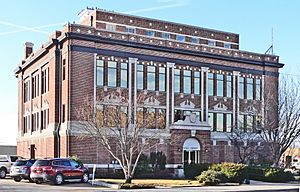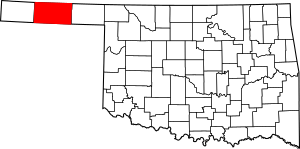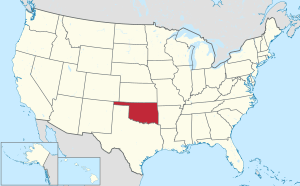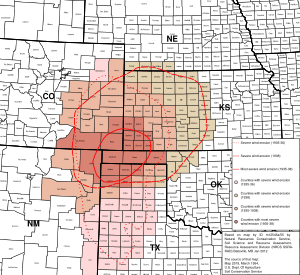Texas County, Oklahoma facts for kids
Quick facts for kids
Texas County
|
|
|---|---|

Texas County Courthouse in Guymon (2012)
|
|

Location within the U.S. state of Oklahoma
|
|
 Oklahoma's location within the U.S. |
|
| Country | |
| State | |
| Founded | 1907 |
| Named for | Texas |
| Seat | Guymon |
| Largest city | Guymon |
| Area | |
| • Total | 2,049 sq mi (5,310 km2) |
| • Land | 2,041 sq mi (5,290 km2) |
| • Water | 7.4 sq mi (19 km2) 0.4%% |
| Population
(2020)
|
|
| • Total | 21,384 |
| • Density | 10.4363/sq mi (4.0295/km2) |
| Time zone | UTC−6 (Central) |
| • Summer (DST) | UTC−5 (CDT) |
| Congressional district | 3rd |
Texas County is a special area in the panhandle of Oklahoma, a state in the United States. Its main town, or county seat, is Guymon. In 2020, about 21,384 people lived here.
Texas County is the second largest county in Oklahoma by land size. It got its name from the state of Texas, which is right next to it on the south side. The county is a big center for farming and raising cattle. It's one of the best places in the U.S. for growing wheat and raising cattle and hogs. Also, a huge natural gas field called Hugoton-Panhandle is found here.
More than half of the people in Texas County (50.6%) are of Hispanic background. This makes it Oklahoma's only county where most people are Hispanic.
Contents
History of Texas County
Texas County was created when Oklahoma became a state on November 16, 1907. It was formed from the middle part of what was called "Old Beaver County." The county was named Texas because it was part of a land deal in 1850. In this deal, the state of Texas gave this land to the United States government.
From 1850 to 1890, this land didn't belong to any state or territory. It wasn't even properly mapped or divided. Then, from 1890 to 1907, it became part of Beaver County before becoming its own county.
Geography and Nature
Texas County covers about 2,049 square miles. Most of this is land (2,041 square miles), with a small amount of water (7.4 square miles). It's the second biggest county in Oklahoma by land area.
The county is mostly flat, like a high plain, but it does have some gently rolling hills. The North Canadian River flows through it. This river is often called the Beaver River in this area. Smaller streams like Coldwater, Hackberry, Goff, Teepee, and Pony Creeks also flow into it.
For visitors, Texas County is part of an area called Red Carpet Country. This name was given by the Oklahoma Department of Tourism.
There's also the Optima Lake project nearby. This includes the Optima National Wildlife Refuge, which is a protected area for animals. There's also the Optima Wildlife Management Area, where people can hunt. These areas are about 2 miles north of Hardesty, Oklahoma.
Neighboring Counties
Texas County shares borders with several other counties:
- Stevens County, Kansas (north)
- Seward County, Kansas (northeast)
- Beaver County (east)
- Ochiltree County, Texas (southeast)
- Hansford County, Texas (south)
- Sherman County, Texas (southwest)
- Cimarron County (west)
- Morton County, Kansas (northwest)
Texas County is one of only four counties in the United States that borders the state it's named after.
Protected Natural Areas
- Optima National Wildlife Refuge is a special place that protects wildlife.
People of Texas County
In 2020, the population of Texas County was 21,384 people. About 42% of the people in Texas County were of Hispanic or Latino background in 2010. Most people spoke English, but about 33% spoke Spanish as their first language.
The population is spread out, with many young people. The average age in the county was 30 years old.
Economy and Jobs

Raising cattle was the most important job in Texas County even before Oklahoma became a state. Farming also became very important after the 1890s. Even after the difficult Dust Bowl period in the 1930s, farming and cattle raising grew strong again.
By 1990, Texas County was a top producer of grain like sorghum. It also harvested a lot of wheat. By 1997, it was the best in the state for raising both hogs and cattle. In 2017, Texas County was the fifth-ranked county in the entire country for the number of hogs produced. A big pork company, Seaboard Foods, is the largest employer in the county.
People started looking for oil in 1922, which led to finding natural gas in the Hugoton Gas Field. Texas County is still the largest producer of natural gas in the nation.
There was a plan for a huge wind farm called Windcatcher in Texas County. It would have had 800 wind turbines. However, this project was canceled in 2018.
Education
In 1909, the Oklahoma Legislature created the Pan-Handle Agricultural Institute. This school offered farming education for the Panhandle area. Over the years, the school grew and changed its name several times.
In 1974, it became Oklahoma Panhandle State University (OPSU). This university is located in Goodwell.
Getting Around
Main Roads
 U.S. Highway 54
U.S. Highway 54 U.S. Highway 56
U.S. Highway 56 U.S. Highway 64
U.S. Highway 64 U.S. Highway 412
U.S. Highway 412 State Highway 3
State Highway 3 State Highway 94
State Highway 94 State Highway 95
State Highway 95 State Highway 136
State Highway 136
Airports
The Guymon Municipal Airport is an airport for public use. It is located about two miles west of Guymon.
Towns and Communities
Cities
Towns
Smaller Communities (Unincorporated)
Historic Places
Many places in Texas County are listed on the National Register of Historic Places. This means they are important historical sites. Here are a few:
- Adams Woodframe Grain Elevator, Adams
- Baker Woodframe Grain Elevator, Baker
- Eva Woodframe Grain Elevator, Eva
- Franklin Hall, Goodwell
- Easterwood Archeological Site, Guymon
- Hooker Woodframe Grain Elevator, Hooker
- Hough Woodframe Grain Elevator, Hough
- CCC Ranch Headquarters, Texhoma
- Johnson-Kline Archeological Site, Texhoma
See also
 In Spanish: Condado de Texas (Oklahoma) para niños
In Spanish: Condado de Texas (Oklahoma) para niños

